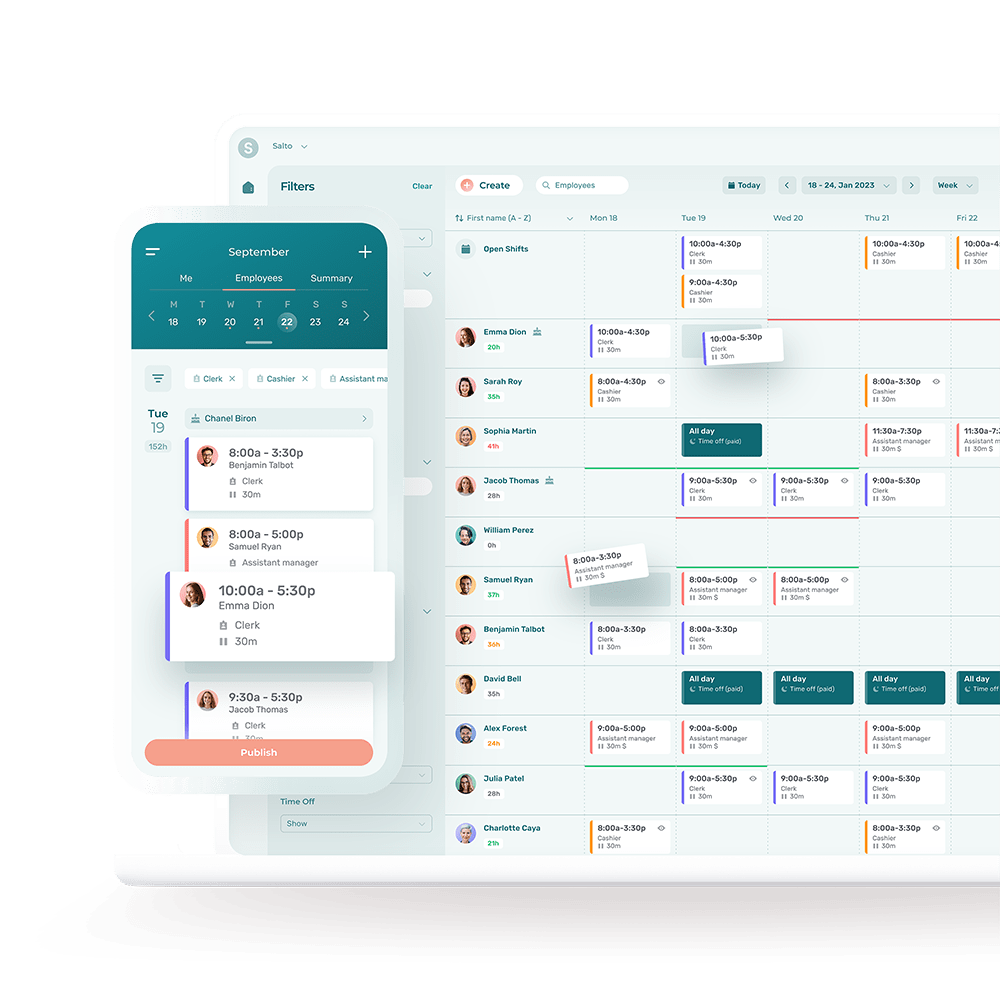Hiring Part-Time vs. Full-Time Employees: 5 Biggest Differences for Your Business
Hiring part-time vs. full-time employees can impact a business’s bottom line.
Learn the difference between full-time and part-time employee work, the pros and cons of full-time vs part-time jobs, and the legal considerations a business owner needs to keep in mind.
Differences Between Part-Time and Full-Time Employment
What Are Part-Time Employees?
Part-time employees clock fewer hours worked per week than full-time workers. They often have flexible schedules, working weekends, evenings, or certain days. Employers hire part-timers to reduce labor costs, handle fluctuating workloads, or offer support during peak periods. Part-timers may not receive the same benefits as full-time employees, depending on company policies and local labor laws.
What Are Full-Time Employees?
Full-time employees work a standard number of hours per week, typically 35 to 40 hours. They usually receive a range of benefits, such as health insurance, paid time off, and retirement plans, depending on the employer and local regulations. A full-time worker generally has a more consistent work schedule and job security than a part-time worker.
Part-Time vs. Full-Time: The Main Differences
1. Hours Worked
Full-time employees typically work a minimum of 35 to 40 hours per week, while part-timers work fewer hours, often less than 35 hours per week.
2. Job Benefits
Full-time salaried employees usually enjoy a broader scope of benefits than their counterparts with part-time jobs paid on an hourly basis, including health insurance, sick pay, paid leave, retirement plans, and other full-time benefits. Some part-timers also receive benefits, but they are often more restricted.
3. Job Security
Full-time employees typically enjoy greater job security than part-time workers. Companies also tend to invest more in full-time staff through training and development and may be more reluctant to lay off full-time workers during economic slumps or organizational restructuring.
4. Consistency in Work Schedule
Full-time employees generally have stable work schedules, with fixed hours and days each week. In contrast, part-time workers often have fluctuating schedules, with changing hours and workdays that can shift on a weekly basis.
5. Eligibility for Overtime Pay
Overtime pay eligibility differs between full-time and part-timers in some countries. Full-time workers may be eligible for overtime pay if they work beyond their standard hours, whereas part-timers may not be eligible or may have different overtime rules. Regulations on overtime pay can vary based on employment contract, industry, or country.
Main Differences in Responsibility an Employer Has Towards Part-Time and Full-Time Workers
Employers have responsibilities towards both part-time and full-time employees, but there are some key differences in how they manage these workers. Here are some main differences in employer responsibilities:
1. Work Hours and Scheduling
Employers are usually responsible for setting work hours for both part-time and full-time positions. For part-time counterparts, they are typically also responsible for scheduling employee shifts.
2. Benefits and Compensation
Employers must provide full-time benefits to full-time workers in accordance with the applicable labor laws. Some employers may choose to offer benefits in excess of federal law requirements to both full-time and part-time workers. Employers must also ensure that part-timers receive equal pay for equal work, as compared to their full-time counterparts.
3. Job Security and Advancement Opportunities
Federal law does not legally require employers to provide job security or advancement opportunities to either full-time or part-time workers. However, some employers may choose to do so as part of their company culture or to attract and retain talented employees.
4. Compliance With Labor Laws
Employers must follow labor laws and regulations for all employees, but requirements may differ depending on their employment status. Eligibility for overtime pay, family and paid sick leave, and legal protections may vary for full-time and part-time workers.
5. Communication and Inclusion
Employers must communicate with all employees, making sure they feel included in the workplace culture. However, employers should make more intentional efforts to include part-timers, who may have less consistent schedules or limited access to company resources and events.
Labor Statistics in the U.S.
- 27.52 million part-time workers vs 132.2 million workers
- 63% of part-time workers are women
- #1 reason why people choose to work part-time: to have time to attend school or a training program
- 1.1 million workers had earnings at or below the federal minimum wage of $7.25 per hour
Save hours every week with user-friendly employee scheduling software that lets you easily manage employees across multiple locations. Includes time and attendance (punch clock), communication and messaging, and more. See how Agendrix scheduling software works!
Pros and Cons of Hiring Part-Time vs. Full-Time Employees
Pros of Hiring Employees Part-Time
1. Cost Savings
By hiring part-time employees, businesses can save on labor costs, as they usually pay for fewer hours worked and may provide reduced benefits compared to full-time employees. This can be particularly advantageous for companies with fluctuating workloads or seasonal demand.
2. Flexibility
Part-time employees can provide flexibility to manage peak periods, cover for absences, or complete specific tasks that do not require a full-time commitment. Employers can schedule part-time workers to accommodate varying business needs and better manage resources.
3. Access to a Wider Talent Pool
Hiring part-time employees allows businesses to tap into a broader talent pool, including individuals who may not be available for full-time work due to personal commitments, such as students, parents, or retirees. This can help companies access skilled workers who bring diverse experiences and perspectives to the organization.
4. Increased Productivity
Part-time employees may be more productive during their working hours, as they can be highly motivated and focused on their tasks. They can also contribute to a more efficient use of resources, as employers can allocate work based on skills and availability, ensuring that tasks are completed in a timely and effective manner.
5. Reduced Turnover and Burnout
By offering part-time positions, businesses can reduce employee turnover and burnout. Part-time work can be an attractive option for employees seeking a healthy work-life balance or for those who are transitioning to retirement or pursuing additional education. As a result, hiring part-time employees can lead to higher job satisfaction and improved employee retention.
Cons of Hiring Part-Time Employees
Offering part-time jobs to employees also comes with some potential disadvantages for businesses:
1. Limited Availability
Part-time employees typically work fewer hours than full-time employees, which may limit their availability for meetings, projects, or other tasks. This can lead to employee scheduling problems and reduced efficiency in some situations.
2. Increased Management and Administrative Tasks
Coordinating and managing the schedules of part-time employees can be more time-consuming for managers and HR personnel. This may require additional resources to accommodate varying schedules and ensure effective communication across the team.
3. Lower Commitment and Engagement
Part-time employees may not feel as committed or engaged with the company as full-time employees, which can impact their job satisfaction and performance. They may also miss out on team-building activities, training, or professional development opportunities that are more readily available to full-time employees.
4. Inconsistency in Performance
With a higher turnover of part-time employees, businesses may experience inconsistency in the quality of work and service provided. This can lead to the need for ongoing training and supervision, potentially affecting overall productivity.
5. Reduced Benefits and Job Security
Part-time employees often receive fewer benefits, such as health insurance, paid time off, or retirement plans, compared to full-time employees. This may make it more challenging to attract and retain skilled workers for part-time positions. Additionally, part-time employees may have less job security, as their hours can be more easily reduced or eliminated during economic downturns or budget cuts.
Pros of Hiring Full-Time Employees
1. Greater Commitment and Loyalty
Full-time employees tend to have a vested interest in the success of the business. This can increase job satisfaction and productivity, and reduce turnover.
2. Consistency and Continuity
Full-time employees provide a consistent and stable workforce. This allows businesses to maintain continuity in projects and tasks.
3. Improved Team Dynamics and Collaboration
Full-time employees are generally more integrated into the company culture and have more opportunities to collaborate and build relationships with their colleagues. This can lead to better teamwork and a more cohesive work environment.
4. Access to a Wider Range of Benefits
Full-time employees typically receive full-time benefits, including health insurance, paid time off, retirement plans, and other benefits. This can make it easier to attract and retain top talent.
5. Better Employee Development and Growth Opportunities
Full-time employees are more likely to have access to ongoing training, professional development, and career advancement opportunities. Investing in the growth and development of full-time employees can lead to a more skilled and adaptable workforce, benefiting the organization in the long run.
Cons of Hiring Employees Full-Time
1. Higher Costs
Full-time salaried employees usually come with higher costs. This can put a financial strain on businesses, particularly smaller organizations or those with tight budgets.
2. Less Flexibility
Full-time employees typically work fixed schedules, which can limit the organization’s ability to adapt to fluctuating workloads, seasonal demands, or unexpected changes in business conditions.
3. Potential for Underutilization
Hiring full-time employees can sometimes result in underutilization of their skills or time if there isn’t enough consistent work to keep them fully engaged. This can lead to decreased productivity, wasted resources and low employee morale.
4. Increased Risk of Burnout
Full-time employees may be more susceptible to burnout due to their longer working hours and greater workload. This can negatively affect job satisfaction, performance, and well-being, and increase turnover rates.
5. More Difficult to Terminate
Terminating a full-time employee can be more challenging than with a part-time worker, as there may be legal requirements, severance packages, and other considerations involved. This can make it more difficult for businesses to respond to changing circumstances or make necessary staffing adjustments.
Part-Time vs. Full-Time Work and Legal Considerations
When hiring part-time and full-time employees, employers must ensure compliance with applicable laws, such as fair labor standards. Some key legal aspects to consider include:
1. Discrimination
Employers must not discriminate between part-time and full-time employees. They must ensure fair treatment in terms of wages, promotions, benefits, or other employment conditions.
Employers must comply with anti-discrimination laws such as Title VII of the Civil Rights Act, the Age Discrimination in Employment Act (ADEA), and the Americans with Disabilities Act (ADA), which protect employees from discrimination based on race, color, religion, sex, national origin, age, and disability.
2. Overtime Pay
The Fair Labor Standards Act (FLSA) requires employers to pay non exempt employees overtime pay (at least one and a half times their regular rate) for any hours worked beyond 40 in a workweek. This applies to both part-time and full-time employees. Employers should ensure they accurately track hours worked and pay appropriate overtime rates when required.
3. Health Insurance
Under the Affordable Care Act (ACA), employers with 50 or more full-time employees (or full-time equivalent employees) must offer health insurance coverage to full-time employees who work 30 or more hours per week. Employers are not required to offer health insurance coverage to part-time employees working less than 30 hours per week.
Employers should carefully track employee hours to determine eligibility for health insurance coverage and comply with ACA requirements.
4. Employee Benefits
Employers should be cautious about providing benefits, such as paid time off, retirement plans, or other benefits to full-time employees while excluding part-time employees, as this could potentially lead to discrimination claims. Employers may provide benefits to part-time employees on a pro-rata basis or establish clear eligibility criteria that comply with applicable laws.
5. Family and Medical Leave
The Family and Medical Leave Act (FMLA) requires employers with 50 or more employees to provide up to 12 weeks of unpaid, job-protected leave per year for eligible employees, regardless of their full-time or part-time status. To be eligible, employees must have worked at least 1,250 hours during the 12 months preceding the leave request. Employers must ensure they comply with FMLA requirements for both part-time and full-time employees.
By being aware of these legal considerations and ensuring compliance with labor laws, employers can avoid potential legal issues and create a fair and equitable work environment for both part-time and full-time employees.
Employee Benefits: What to Offer to Part-Time vs. Full-Time Employees
Benefits are a major draw for both part-time and full-time employees and may help a business attract better quality-talent.
Small businesses with less than 50 employees are not legally obligated to offer health insurance or other benefits to their employees, but some may choose to do so if they can afford it.
Larger businesses are legally required to provide full-time employees statutory benefits such as social security and medicare, unemployment insurance, and workers compensation insurance.
However, rules can vary by state. They are not required to extend these same benefits to part-time employees. Again, however, some may choose to do so to improve job satisfaction and give their employees a better work-life balance.
Depending on company policy, part-time employees may still receive some benefits, such as the opportunity to work flexible hours.
10 Companies That Offer the Best Benefits for Part-Time Workers
The following 10 companies have built a great reputation for supporting the work-life balance of their part-time employees.
1. Chipotle
- Health, vision, dental and wellness coverage
- 401(k) with match
- Discounts on food
- Educational assistance
2. Macy’s
- Health and retirement benefits
- Flexible schedules
- On-the-job training
- Discounts on all Macy’s merchandise
- Chance to be in the Macy’s Thanksgiving Day Parade
3. REI
- Variety of medical plans, including for dependents
- Most costs covered for medical plan; all costs covered for basic life and disability plans
- Additional options like vision care, orthodontia and long-term care coverage
- Employee discount programs
- Yay days (one day off every six months for outdoor activities)
- Challenge grants (to put toward goals like climbing Mt. Everest)
4. Costco
- Health and life insurance
- Dental and vision care
- 401(k) plan with match
- Discounts on prescription medication
- Child care assistance
- Employee premium portions or costs withheld pre tax
5. Lowe’s Home Improvement
- Medical, dental, and vision insurance
- Life and disability insurance
- Health and wellness programs
- Learning and development programs
6. Staples
- Vision and dental benefits
- Life and dependent life insurance
- Accidental death
- Short-term disability
- 401(k) plan
7. Starbucks
- Choice of multiple coverage levels for medical, dental, and vision plans
- Life insurance
- Disability
- Accident coverage
- Possibility of comprehensive healthcare and dependent care coverage
- Discounted stock purchase options
- 401(k) with match
- Educational savings
- Time-off program
- Partnership with Arizona State University to earn a bachelor’s degree with full tuition reimbursement
- In-store discount and one free pound of coffee, K-cup pack or tea tin per week
8. Kaplan
- Third-party company to help employees enroll in health insurance
- Supplemental hospital plan
- Life insurance
- Dental and vision rider options
- Disability insurance
- Prescription discount cards
- Free or discounted Kaplan courses
9. Coffee & Bagel Brands
- Medical, dental and vision
- 401(k) program, for which the company will match 25 cents for every dollar contributed
- Discount at all company-owned locations
10. World Market
- Limited benefits plan for preventative care, health and wellness for eligible part-time employees
Job Sharing vs. Full-Time Work
Job sharing is a flexible work arrangement where two or more employees share the responsibilities of one full-time position. Each employee typically works part-time hours and shares tasks, responsibilities, and compensation.
Job sharing is often a win-win for both employees and employers.
Benefits of job sharing for employees
Job sharing lets employees have a better work-life balance, share childcare or other responsibilities, and pursue other interests or hobbies.
Benefits of job sharing for employers
Job sharing can increase employee productivity, reduce turnover and absenteeism, while ensuring coverage for extended business hours. It can also help attract and retain skilled workers who may not be able to work full-time due to personal or family obligations.
Part-Time vs. Full-Time Hours for Your Business
Business owners should consider their specific needs and goals to determine whether their business will be best served by offering part-time or full-time positions. Factors such as workload, budget, and desired level of flexibility can all play a role in this decision.
Business owners should evaluate their staffing needs and consider whether they need full-time employees to handle the workload consistently, or if part-time staff can provide the necessary support with more flexibility.
They should also consider the costs associated with each option, including benefits and training costs. Managing a full-time team will also require time spent on creating, communicating, modifying and tracking employee work schedules.
Ultimately, the decision should align with the company’s goals, values, and overall business strategy.
Conclusion
Choosing between full-time and part-time workers is an important decision for business owners, as it can have a significant impact on employee retention, productivity, and business performance. For some businesses, the best decision may be to hire a combination of full-time and part-time staff.
Easily create work schedules for full-time and part-time workers, track time an attendance, enable shift swaps, grant time off request and streamline payroll with Agendrix’s workforce management software.
Why Offer Part-Time vs. Full-Time Jobs?
Offering part-time and full-time work can benefit businesses in different ways.
Part-time work can be cost-effective as employers pay for fewer hours worked and may not have to provide certain benefits like health insurance. This is particularly advantageous for companies with fluctuating workloads or seasonal demand.
Part-time work can also offer flexibility to employees, which can be attractive to those with other commitments like family or education.
How Many Hours in Full-Time vs. Part-Time Employment?
The number of hours that constitute full-time vs. part-time employment can vary by country, industry, and employer. In the U.S., the Fair Labor Standards Act (FLSA) does not define full-time or part-time employment, but some employers define full-time work as 35 to 40 hours per week, while part-time work may be anything less than that, depending on the company’s internal policies.
Depending on the number of hours worked per week, employers may be legally required to provide employees with specific benefits. Business owners should check the relevant labor laws to determine the number of hours that constitute full-time vs part-time employment.
Do Part-Time Employees Get Health Insurance?
Employers in the U.S. aren’t required to provide health insurance for part-time employees, even if they provide coverage for full-time status employees.
What Types of Businesses Are Best Suited to Full-Time Positions?
Full-time positions are a good fit for businesses that require consistent and continuous operations or that require employees to work on-site for set hours each day.
For example, manufacturing, healthcare, education, and government sectors typically require full-time employees to keep their operations running smoothly.
Businesses that require specialized skills or training, such as engineering or software development, may also benefit from having full-time employees who can focus on their work and develop their expertise over time.
What Types of Businesses Are Best Suited to Hiring Part-Time Employees?
Part-time employment can be beneficial for various types of businesses, including:
- Retail and hospitality: These businesses often experience fluctuations in customer demand and require flexibility in their workforce to handle peak periods.
- Small businesses: Startups and small businesses may not have the budget or need for full-time staff, making pull-time employees a cost-effective solution.
- Seasonal businesses: Businesses that operate only during certain times of the year, such as ski resorts or ice cream shops, may rely on pull-time workers during their peak season.
- Non-profit organizations: Non-profit organizations may have limited budgets and may need to fill positions on a pull-time basis.












